The UACJ Group’s Long-term Roadmap, UACJ Vision 2030
Aiming to put its corporate philosophy into practice, UACJ has formulated a long-term management vision that outlines the contributions for the UACJ Group to make through to 2030. Guided by this roadmap, the Group will bring together the skills and expertise it has honed over the last 100 years to expand the possibilities of aluminum and contribute to the realization of a sustainable and prosperous society.
- Approach and Objectives
- Four Ways of Contributing
- Materiality Issues
- Financial and Non-Financial Targets
Approach and Objectives
Aiming to help build a sustainable world by utilizing the benefits of aluminum, UACJ has specified four ways for the Group to contribute in new business sectors.
Building a sustainable world by utilizing the benefits of aluminum
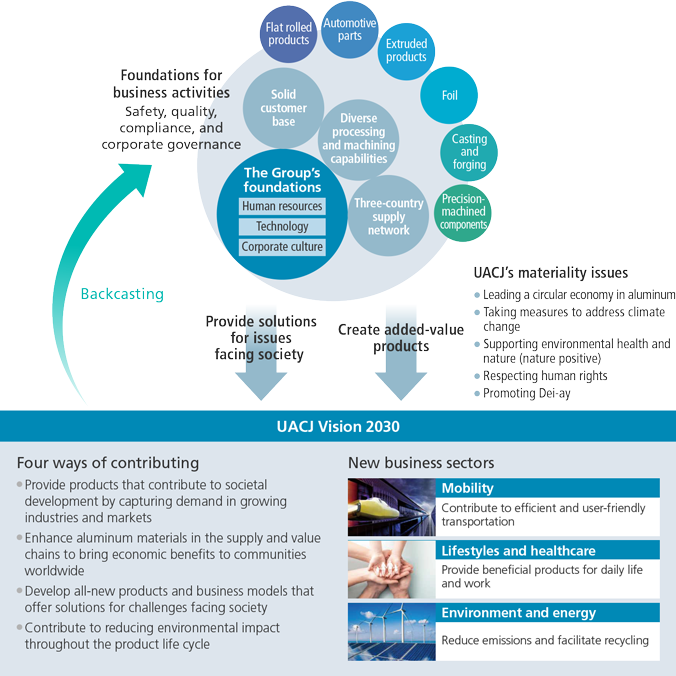
Four Ways of Contributing
1. Focus on Growth Sectors and Markets
Expand in scale, primarily in growth markets (North America, Southeast Asia) and growth sectors (can stock, the automotive industry)
We have enhanced production capabilities by carrying out focused advance investment in TAA*1 and UWH*2 in North America and in UATH*3 in Thailand. We will fully utilize these capabilities by positioning can stock, where a huge rise in global demand is anticipated, and automobile materials, which is expecting a shift to aluminum products and an increasing need for lighter vehicle bodies, as growth sectors. We will expand the scale of our business in these sectors with a focus on markets in North America and Asia, where growth is anticipated.
- *1 Tri-Arrows Aluminum Inc.
- *2 UACJ Automotive Whitehall Industries, Inc.
- *3 UACJ (Thailand) Co., Ltd.
Demand for can stock (Thousands of tons)
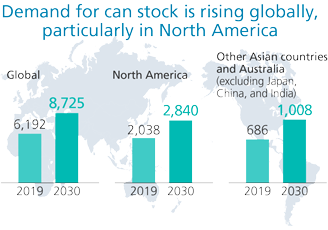
- Source: CRU aluminium rolled products market outlook December 2023 report
2. Increase the Added Value of Enhanced Material
Increase earning power by attaching new value to materials (plasticity processing, recycling, modules, services, etc.)
We are engaged in a wide variety of businesses, including flat-rolled aluminum, automotive parts, extruded products, aluminum foil, cast and forged products, and precision-machined components, and we have built a robust customer base. Therefore, one of our strengths is the ability to accurately and deeply understand market needs based on wide-ranging contact with these markets and then shape materials that meet these needs. We will fully leverage our technological advantage and business base to provide enhanced materials that create new environmental value, such as completely new processes, the use of big data related to industrial processes, and recycling. In this way, we will grow sales and our customer base.
Examples of strengths and value delivered
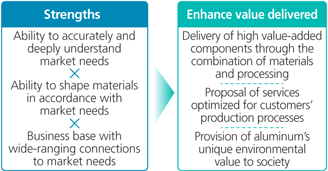
3. Creation and Expansion of New Business Domains
Expand business in the three domains of lifestyles and healthcare, mobility, and environment and energy
Aluminum has a variety of characteristics. Combining these characteristics with basic technologies such as material, design, functional design, and production technologies and practical technologies such as joining and bonding technology and heat management technology, enables the creation of a wide range of products. At UACJ, we are refining these basic and practical technologies with the aim of expanding our business into new sectors.
Also, in the same way as we developed our automotive parts business by interlinking the flat-rolled aluminum, extruded products, and precision-machined components businesses, we will leverage all six of our businesses to use the expertise gained from domains connected to each business and synergies among businesses as a platform for creating new business domains.
Leveraging technological expertise to expand business areas
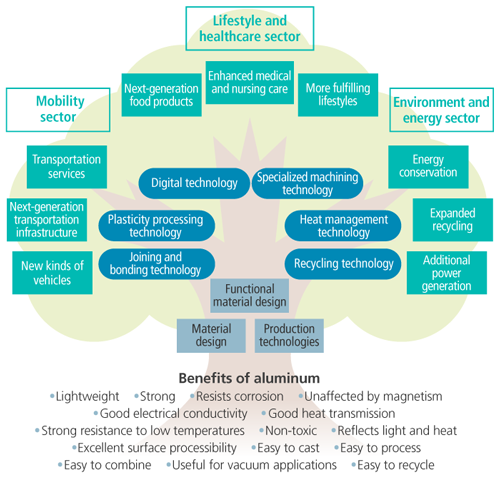
4. Reduce Environmental Impact
Reduce environmental impact across the entire supply chain through measures such as raising recycling rates
In regard to aluminum product lifecycles, manufacturing products from new aluminum results in the most CO2 emissions while manufacturing from recycled aluminum can cut these emissions by 97%.
At UACJ, we are promoting recycling in addition to efforts such as reducing CO2 emissions in our internal manufacturing processes and supplying aluminum components that help make products lighter and more heat efficient. The UACJ Group is aiming to become carbon neutral (in terms of Scope 1 and 2 emissions) by 2050.
Reducing environmental impact across the entire value chain
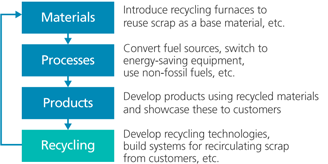
Materiality Issues
UACJ has established the UACJ Group Sustainability Policy with a view to help build a sustainable world. In accordance with this policy, the Group has specified five materiality issues that it will work to address on a priority basis going forward. All of the Group’s members are working towards goals related to these issues, which are linked to the UN Sustainable Development Goals.
The UACJ Group’s Materiality Issues
- Leading a circular economy in aluminum
- Taking measures to address climate change
- Supporting environmental health and nature (nature positive)
- Respecting human rights
- Promoting Dei-ay
Financial and Non-Financial Targets
Financial targets
| Fiscal 2030 | |
|---|---|
| Revenue | ¥1,100.0 billion |
| Business profit ratio | 6.0% |
| Return on equity | 10.0% |
| Return on invested capital | 10.0% |
Non-financial targets
Key sustainability issues (materiality)
Three materiality issues related to the environment
| Key sustainability issues (materiality) |
Issues to be addressed | Target to be achieved by FY2030 | Target to be achieved | Scope | ||
|---|---|---|---|---|---|---|
| Fiscal year | Target | Benchmark | ||||
| Leading a circular economy in aluminum (circular economy) |
Maximize recycling rate of aluminum alloys | UACJ Recycling Rate Circulated aluminum amount/Amount charged into the melting furnace *Excludes pure aluminum material |
2050 | 100% | FY2019 65% |
Flat Rolled Products Business Extrusion & Metal Components Business |
| 2030 | 80% | |||||
| Taking measures to address climate change |
Challenge towards carbon neutrality (Scope 1&2) |
Reduction of Scope 1 and 2 emissions The calculation is based on the Sixth Strategic Energy Plan |
2050 | Achieve carbon neutrality | FY2019 per unit of production |
UACJ Group as a whole (Scope of report) 13 locations in Japan and 9 locations overseas *Reportable locations as of FY2023 |
| 2030 | 30% | |||||
| Minimize GHG emissions along the entire supply chain (Scope 3) |
Reduction of Scope 3 emissions Category1 |
2050 | Minimize GHG emissions along the entire supply chain |
FY2019 per unit of production (Category 1) |
UACJ Group as a whole (Scope of report) 8 locations in Japan and 2 locations overseas *Reportable locations as of FY2023 |
|
| 2030 | 30% | |||||
| Supporting environmental health and nature (nature positive) |
Minimize water intake through the effective use of water | Reduction in water intake amount Water intake includes industrial water, tap water, well water, and surface water |
2030 | 25% or more | FY2020 per unit of production |
UACJ Group as a whole (Scope of report) 23 locations in Japan + UATH |
Two materiality issues related to well-being
| Key sustainability issues (materiality) |
Issues to be addressed | Target to be achieved by FY2030 | Target to be achieved | Scope | ||
|---|---|---|---|---|---|---|
| Fiscal year | Target | Benchmark | ||||
| Respecting human rights | Eradicate human rights abuses | Human rights due diligence implementation rate Total number of employees of Group companies and locations here human rights due diligence has been conducted / Total number of employees of Group companies |
2030 | 100% | FY2022 21% |
UACJ Group as a whole |
| Educate on compliance and human rights issues through the Group Code of Conduct |
Pervasiveness of respect for human rights Average score of employee engagement survey items relating to compliance and human rights |
2030 | 3.9 / 5.0 | FY2023 3.6 |
UACJ Group as a whole (Scope of report) UACJ Corporation + Group companies in Japan *Scope of employee engagement survey |
|
| Promoting Dei-ay | Promote Dei-ay | Pervasiveness of Dei-ay Average score of employee engagement survey items relating to pervasiveness of Dei-ay |
2030 | 3.4 / 5.0 | FY2023 3.1 |
UACJ Group as a whole (Scope of report) UACJ Corporation + Group companies in Japan *Scope of employee engagement survey |
| Promote diverse human resources | Percentage of women in managerial positions Excluding board members |
2030 | 15% | FY2023 8.5% |
UACJ Group as a whole | |
Other important initiatives
| Other important initiatives | Issues to be addressed | Assessment criteria | Target to be achieved | Scope | ||
|---|---|---|---|---|---|---|
| Fiscal year | Target | Benchmark | ||||
| Product quality assurance | Establishment of a quality control structure for the UACJ Group (Making this a matter of course at UACJ) |
Number of serious quality defacts | 2030 | Zero | - | UACJ Group as a whole |
| Number of customer complaints due to te fault of materials | 2030 | Half the number in FY2020 | FY2020 results |
|||
| Occupational health and safety | Building capabilities and a culture to sustain zero serious workplace accidents (Making this a matter of course at UACJ) |
Number of serious workplace accidents | 2030 | Zero | - | UACJ Group as a whole |
| Reduce the workplace accident frequency rate (Making this a matter of course at UACJ) |
Frequency of workplace accidents resulting in injury or death per million workours |
2030 | 0.08 | - | ||
| Coexistence and co-creation with local communities |
Creation of various experience opportunities for children who will lead the next generation |
Number of beneficiaries of educational support activities | 2030 | 1,000 people/year | - | UACJ Group as a whole |
| Human resources development | Develop human resources to create new business (Strengthen human resource capabilities) |
Number of people involved in new business development | 2030 | Cumulative total of more than 30 people | - | UACJ Group as a whole |
- Note: UACJ Group as a whole: UACJ Corporation and its consolidated subsidiaries (excluding equity method affiliates and holding companies)
- Note: An index for evaluating the frequency of occupational accidents calculated by converting the total number of serious occupational injuries and death (including those that did not result in a suspension of operations)

